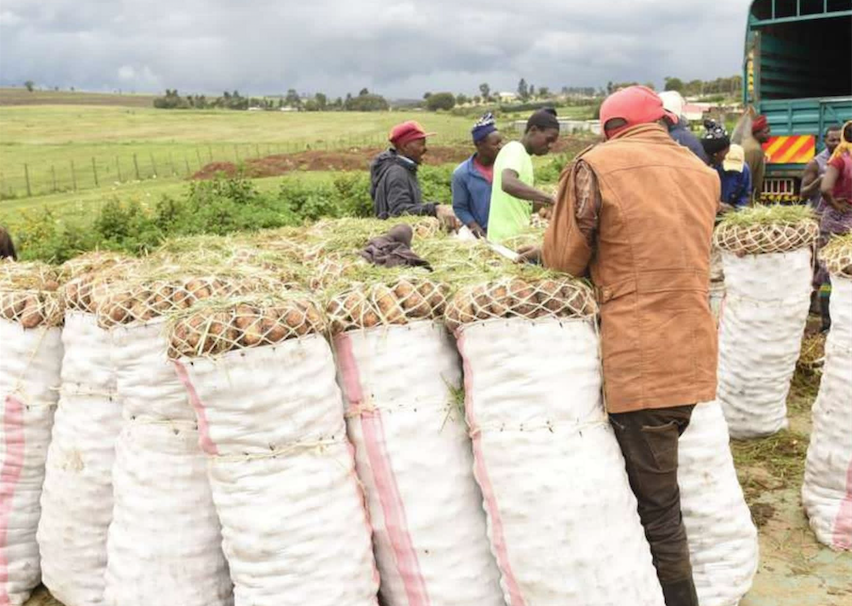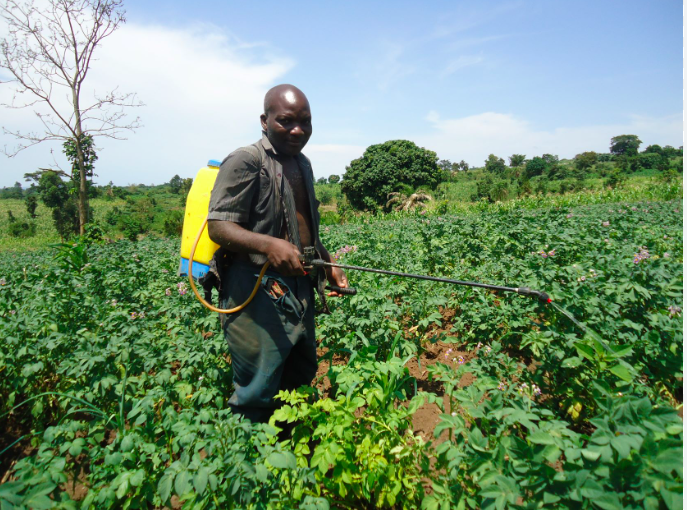 Potato farmers in Nyahururu sell their crop after a bumper harvest.
Potato farmers in Nyahururu sell their crop after a bumper harvest.
You may be getting more than you bargained for with the famous cash crop of Nyandarua –potatoes.
Most of these fat tubers come loaded with residues of banned pesticides and boiling them will not help much, researchers from Egerton University warn.
Millicent Kanario, and her two senior colleagues from the university’s Department of Dairy and Food Science and Technology, have traced the problem down to the farms.
They visited 275 randomly selected potato farmers in Nyandarua County and nearly all of them (98.8 per cent) used synthetic pesticides.
Most farmers used synthetic pesticides regularly, sometimes even weekly, and many mixed different types together. Only 12 per cent of the farmers actually followed the instructions on the pesticide labels.
“We found that the majority of farmers rely on advice from agrochemical retailers or other farmers, rather than the official manufacturer’s guidelines,” Kanario and her seniors Prof Joseph Wafula and Dr John Masani reported.
Their report – titled, “Influence of on-farm pesticide practices and processing methods on pesticide residue levels in potato tubers (Solanum tuberosum L.) in Nyandarua County, Kenya” – has been accepted for publication by The Journal of Food Protection, but has not been published yet.
Some of the chemicals widely used, and which definitely find their way to Kenya’s dinner tables are, are banned in Europe and other parts of the world.
Among the most worrying were chlorpyrifos and fenitrothion. These two insecticides are widely linked to serious health issues like brain damage and hormone disruption. These were found in potato samples at levels above international safety limits.
Kanario and her colleagues tested raw and cooked Shangi potato variety samples from sampled farmers for some of the most commonly used pesticide residues.
“The banned insecticides containing chlorpyrifos and fenitrothion were found at levels exceeding the EU and Codex maximum residue limits (MRLs),” they said.
Codex limit, developed jointly by the Food and Agriculture Organization (FAO) and the World Health Organization (WHO), is the highest level of a pesticide residue that is legally tolerated in or on food or feed when pesticides are applied correctly.
The Pest Control Products Board has been phasing out chlorpyrifos-based pesticides for agricultural use. The phased withdrawal was set to be completed by December 31, 2024, due to concerns about the pesticide's potential negative impacts on human health, particularly in children, and its environmental effects.
On the other hand, Fenitrothion causes high human toxicity and can induce significant damage of the brain, lung, liver, and kidney leading to imbalance in their functionality. It has been proposed for phased withdrawal from Kenya since 2000 by Route to Food Initiative, a local nonprofit that tracks highly toxic pesticides banned in other parts of the world but still available in Kenya.
So, what does this mean for the person eating those potatoes? It means that harmful chemicals may be making their way from the soil into your lunch or dinner.
To find out whether cooking could make the potatoes safer, the researchers tested five common methods: frying, boiling, steaming, baking, and roasting.
Their results were eye-opening.

Most farmers spray their crop frequently, but they do not follow the manufacturers directions.
Frying came out on top. It reduced pesticide levels more than any other method, especially for some of the most dangerous chemicals. For example, frying cut levels of azoxystrobina –common fungicide – by over 92 per cent.
Boiling
helped, but not as much. It was better at removing water-soluble pesticides but
struggled with oily or heat-stable ones. “Boiling was less effective for some
compounds like azoxystrobin, which only reduced by 10.6 per cent,” the researchers noted.
And roasting? That was the worst option.
“Roasting was the least effective method across the board,” the study stated. In some cases, more than 80 per cent of the pesticide residue remained even after roasting. The researchers explained that roasting does not involve water or oil, which are key in helping draw out or break down the chemicals. It also does not reach high enough internal temperatures to destroy the residues.
“Worth noting, some insecticides, like fenitrothion and chlorpyrifos, remained above their MRLs after frying, baking, and roasting, indicating potential health risks.”
Why do farmers use so much pesticide? It is partly fear, fear of losing their crops to disease and pests. The Shangi variety is highly popular because it grows fast and sells well. But it is also vulnerable. Many farmers spray on a schedule, not because pests are present, but just in case they show up.
Others say they mix different chemicals together to save time or increase effectiveness. But this practice can make things worse, creating toxic combinations and leaving higher residues in the food.
One farmer said he sprays “every seven days like clockwork.” But that kind of routine leaves little time for the chemicals to break down before harvest. Many farmers harvest just three weeks after spraying – far too soon, according to food safety guidelines.
Despite these serious risks, there is hope.
The
study shows that changing how we cook potatoes, especially by frying or properly
boiling, can
significantly reduce the danger.
It says: “Based on these findings, consumers concerned about pesticide exposure may consider fried and boiled potatoes over roasted potatoes.”
More importantly, educating farmers about safe pesticide use could prevent the problem from starting in the first place.
“Expanded educational initiatives to promote good agricultural practices among potato farming communities are urgently needed to ensure food safety and environmental sustainability,” the authors concluded.









